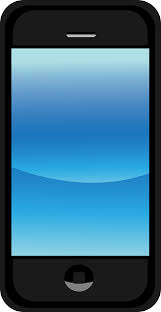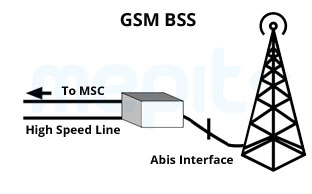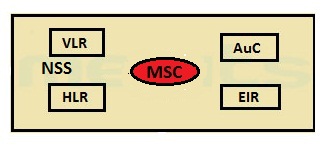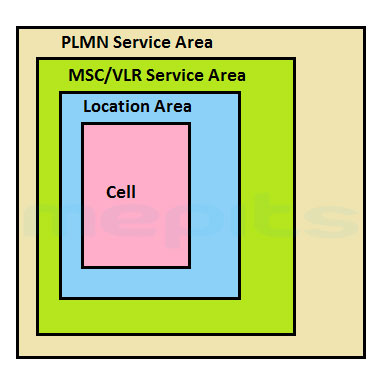GSM or Global System for Mobile Communications is an international standard for mobile communication based on TDMA. GSM describes a set of protocols for mobile phones that use 2G digital cellular networks. The technology started in Europe and later migrated to other continents, which now covers almost 219 countries. GSM operates in several frequency bands, including 900 MHz in Asia and Europe and 1.9 GHz in the U.S. GSM's TDMA technology is about a circuit-switched network system that splits 200 kHz channel each, into 25 kHz eight time slots.


TDMA (Time-Division Multiple-Access) allows multiple users to access a channel for specified period of time. For GSM, 30KHz wide narrow band with 6.7 milliseconds length is divided into three slots based on time. Each receiver gets the channel for one-third the total time. GSM sends data after digitizing and compressing it with user data of two other streams. Each data is send during its time slot. Quad-band devices ate those which support all four bands. Tri-band and dual-band are those which support 3 or 2 bands respectively.
GSM Network architecture can be divided into following parts:

Physical equipment consisting of radio transceiver, digital signal processors and displays, and the Subscriber Identity Module (SIM) is the main components of a mobile station (MS). The mobile station
Subscriber Identity Module (SIM)- SIM card consists of user’s information on subscription and also includes phone book. It is a detachable card that permits the users to store one’s unique information even after changing mobile handsets. User also has the privilege to change the GSM networks by changing the SIM and retaining the handset. There are certain network operators whom provide there SIMs with their company handset which will not support any other SIM or rather locked to other SIMs to avoid the changing of SIM on user’s sole interest. The process is called Phone Locking and it is done with the help of software. The locking can be removed after approaching the network dealer or use private services which includes the use of websites and software for unlocking.
The Mobile station acts as the receptor for SMSs, which enables the user to switch between the data and voice usage. The Mobile Station also provides access to many services like voice messaging services, user data services.

The Base Station Subsystem consists of two divisions: the Base Transceiver Station (BTS) and the Base Station Controller (BSC). The communication between BTS and BSC is done across the specific Abis interface which enables the components made from various suppliers to carry out operations between them. A BSS consists of base stations, may be one or more, and radio components consists of four to seven or nine cells. Abis interface is used between BTS and BSC. BSS to Mobile MSC is connected via high-speed line.
Radio Transceivers are housed in BTSs to define a cell and to handle protocols relating to radio-links with the mobile station. A BTS is usually found in the center of the cell, which corresponds to respective cell’s transceivers and antennas. Size of the cell is defined by the transmitting power. Depending on the amount of users in the particular cell, the number of transceivers can vary from 1 to 16 in each BTS. BTS individually act as a single cell. BTS performs functions like encoding, decoding, encrypting, decrypting, synchronization of time and frequency etc.

The connection between the MSC and mobile is BSC. BTS is meant to handle frequency hopping, radio channel setup and handovers. The Radio resources are managed by BSC in case of one or more BTSs. The 13kbps voice channel is translated to 64kbps channel over radio link by BSC, so that it is used by the Public Switched Telephone Network (PSDN).
BSC performs functions such as:
The Mobile Switching Center (MSC) is the main part of the Network Switching System (NSS), which does the calls switching between mobile and other users, that is, fixed or different network users. It also manages different mobile services like authentication.

The following functional parts are included in switching system:
HLR is basically a database operated by network operators that stores information about the SIM user. Information includes users service profile, activity status and location details. HLR is an important database for storage and subscription management.
MSC is the central part of Network Switching system of an operator which performs the operation of switching to and from other mobile network operators or fixed users. MSC also performs mobile services management like call routing, location updating, authentication, network interfacing etc. There is a unique ID for every MSC.
The VLR is a part of MSC which is basically a database that includes temporary information relating to the subscribers that is required for the MSC so as to service a visiting subscriber. When a user is roaming in a new MSC region, then the VLR, that is part of that MSC area, gathers information from the HLR relating to the new mobile station. Further, when the mobile station initiates a call, all the information required to setup a call is available with the VLR, so that VLR need not request the HLR for the same each time.
AUC is a database that is meant for the storage of secret keys belonging to each user’s SIM card which can be used for the purpose of authentication. The AUC provides security to the network operators from fraudulent practices that are seen in today’s mobile world.
The EIR is basically a database that enlists all mobile equipment that is valid in the network. These include the International Mobile Equipment Identity (IMEI) which is identified by each mobile station. In case, if the mobile equipment is stolen IMEI is noted as invalid.
(d). The Operation and Support System
The BSC and all equipment in switching system are connected with the Operations and Maintenance Center (OMC). The Operation and Support System (OSS) is the implementation of the operations and maintenance center. The OMC functions include:
The network operator controls and monitors the system from the OSS. Customer is offered with cost-effective backing for different activities such as local, regional and centralized operational activities and also maintenance activities by the OSS which are essential for GSM networks.
The GSM Network consists of the following geographic areas:

One base transceiver station gives radio coverage to an area termed as Cell. Each cell is assigned with a cell identity number called the Cell Global Identity (CGI).
The Group of cells combines to form location area and the subscriber is paged in this area. One or more BSCs and a single MSC serves in each location area. Location Area Identity (LAI) number is the unique number given to each location area.
The portion of the GSM network area that is being served by a single MSC, which is reachable due to its registration in VLR of the particular MSC, is represented as MSC/VLR service area.
One network operator serves a particular area which is termed as Public Land Mobile Network (PLMN) service area.
Telephony and data are the two basic services provided through GSM. Telephony services provide the users with ability to communicate by voice with different subscribers. Data services allow the user to transfer required data signals among two access points. Additional to these services, other subscriber services include:
DTMF (Dual-Tone Multi-Frequency) — Various control purposes uses tone signaling scheme via telephone network. Full originating DTMF is supported by GSM.
Short Message Services – It is a facility provided by GSM network, which allows any mobile station to send or receive a text consisting of a maximum 160 alphanumeric characters. The message facility provides an advantage of storing and re-sending the message, which was sent when the user’s phone was switched off or out of coverage area, immediately as user comes back to coverage area or when the phone is on.
Voice Mail – Subscriber controlled service within the network and acts as an answering machine. Voice-mail box consists of the forwarded calls and the user can check through the messages using a personal security code.
GSM provides another set of services known as supplementary services which are normally revenue-generating features. GSM services include:
Call Forwarding – This feature allows a mobile unit to forward its incoming calls to another number unconditionally or due to reasons such as mobile unit is busy, no reply etc.
Barring of outgoing calls – This service prevents all outgoing calls from a particular mobile unit.
Barring of incoming calls – This service prevents incoming calls from a subscriber. The two conditions of barring existing are incoming calls being barred and incoming calls barred during roaming.
Advice of Charge (AoC) – The mobile subscriber gets an approximation of the call charges using this service.
Call Hold – This service is available for local telephony. It enables the user to block or interrupt an existing ongoing call and re-establish the call subsequently.
Call Waiting – It is a service that provides the subscriber with a notification of an incoming call during an ongoing conversation. The user can either answer or ignore the call. All GSM networks provide this facility.
Multiparty Service – It is a service available with normal telephony. This service provides a facility to communicate with three or six subscribers simultaneously.